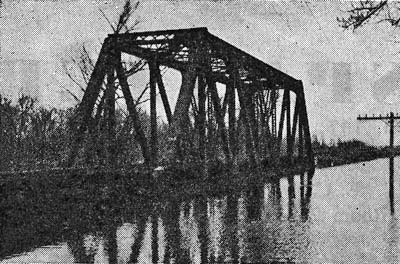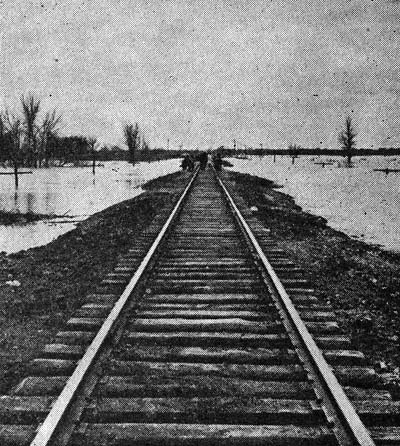
July - 1948
Rampant Waters Bring Operating Headaches
Unceasing Efforts See Job Completed
By F. L. SPENCER

Keep the trains moving was the by-word on the prairie region when floods paralleling any that had ever been seen in the west swept the country from Winnipeg to the eastern rim of the Rockies. Rivers and creeks overflowed their banks with murky, churning, water developed by a sudden thaw after repeatedly heavy snowfalls. Every available man in all districts was alerted to the emergency to help stem the onrushing water which threatened the Company lines in countless places.
During the flood period main line schedules were maintained only through the constant and untiring efforts of the operating men over the entire region. The transcontinental trains were delayed at times but there were no cancellations. Branch line traffic was only cancelled in isolated cases and only after every effort had been made to rectify major washouts before the scheduled times of the trains. Rerouting became a routine matter and although it caused delays the trains went through.

Geared into high speed efficiency the whole department from the general manager, down through the general superintendents, superintendents, roadmasters, and their assistants, as well as the hundreds of men on the business end of picks and shovels, and on heavy equipment worked on round-the-clock schedules to keep traffic moving. It was a magnificent effort and the record of it can be found in a series of cryptic files in the office of the vice-president at Winnipeg. Hours of back breeaking work are recorded in as little as two words, "job completed".
Thousands of tons of rock ballast, cinders, and sandbags were poured, packed, and rammed into the huge gaps
in the roadbed. More than 20,000 ties and 50,000 sand bags were used for cribbing and breakwaters, and
quantities of bridge building materials were needed to strengthen and repair weakened and damaged spans. The men
worked constantly to the deadline of local train schedules. Superintendents were on the line continuously. Sleep
became something they grabbed in 20 minute periods on the back seat of a track motor or wherever they happened
to be when a short-lived lull came in the operations.

At Minnedosa, Manitoba, citizens and railwaymen watched with anxious eyes the steadily mounting lake of
water in the reservoir behind the government dam. Desperate attempts were made to release the water through the
gates under control, but gradually the wall gave way. First one wing and then the other went out. Finally the
main wall crumbled with a rush and a roar releasing more than 20,000,000 gallons of water over the town and the
Company's property. Eight hundred feet of fill was washed out like so much chaff on the Company's right-of-way
east of the town, to an average depth of two feet. Two bridges in the flooded area were saved from destruction
by the foresight of the men on the job who had previously loaded gravel cars placed on the bridges to help hold
them steady.
Just before the Minnedosa dam went out the repair crews of the Manitoba district had been concentrated on the Emerson subdivision over which the Soo line runs into Wininpeg from Minneapolis. Here the Red River had gone on the rampage, but although the town was flooded to a depth of several feet the road bed of the Company line remained high and dry, and at no time was there any interruption in the twice daily service of the Soo line train. For several miles out of the town the thin steel line of Company track and the built up right-of-way was the only dry spot. On both sides of the track water spread for miles and in places the tops of 29 foot telephone poles were the only objects breaking the smooth surface of the flood lake.
On the La Riviere subdivision nearly a week of washouts kept the crews working at top speed to keep the lines open.

With the main trouble centred around the town of Rosenfeld work trains worked out of there over the La Riviere, Carman, and Gretna subdivisions. Crews from Winnipeg were stationed at Rosenfeld and it was from there they operated to maintain the service on the branch lines. Although trains on the La Riviere sub were cancelled on two days they were rerouted over the Carman line and at no time, except in the actual flooded areas, were towns without train service. Work on the Gretna sub had to be abandoned for several days, and the trains were not able to get through, but the mail and express was carried daily by truck into Rosenfeld where it was reloaded onto trains for shipment.
Across the dry plains of Saskatchewan over which Company lines run almost in straight lines great bodies of water suddenly appeared in valleys, gulleys, and almost every low spot on the prairies. The whole province became a series of lakes divided only by high land. Rivers and streams swelled over the banks and wandered all over the rich farm land while the winter's snow melted so rapidly there was little chance for it to run off the land and it just stayed in great pools. The right-of-way of the Company on the main and branch lines in the district was flooded in so many places that it was possible only to tend to those which threatened to hinder train movements. With every available man on the job, plus 200 extra men hired for the emergency, crews operated all across the district moving their repair equipment from one washout to the next. At Kranau, on the Tyvan subdivision, anxious watch was kept on the P.F.R.A. irrigation dam and all preparations were made to cope with the emergency if the dam went out. Eventually, one afternoon, the main wall of the dam heaved, shuddered and crumpled in front of the steadily mounting lake of water behind it, releasing 1,080 acre feet of water over the countryside. It hit the Company lines at Tyvan and ripped out 1,400 feet of track and dump and damaged another 1,000 feet of dump. Four work trains and crews as well as B&B men and a bulldozer converged on the scene like a swarm of ants and made temporary repairs in time to let the next scheduled train go through. On the Portal sub, where the Soo line enters Saskatchewan, 550 feet of track was washed out to a depth of from four to twelve feet and two work trains, two pile drivers, all available section hands, as well as two B&B gangs worked on the damage for four days before the trains could get through again.
At Lloydminster on the Alberta-Saskatchewan border great hunks of ice were forced out of the river course by the mighty rush of water. So great was the force behind it that when it hit the Company line it peeled the track off a mile and a half of dump and shoved it as far as 300 feet away from the roadbed. In one spot whole sections of the track were ripped up on edge and wound around the telephone poles.
All over the district it was the same story.

 and is reprinted here with their permission. All photographs,
logos, and trademarks are the property of the Canadian Pacific Railway Company.
and is reprinted here with their permission. All photographs,
logos, and trademarks are the property of the Canadian Pacific Railway Company.